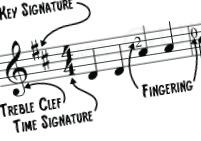
Lesson five in Guitar Command's 'Learn To Play Guitar In Two Months' series of lessons teaches you how to read music for guitar. It contains everything you need to know to start reading music, and covers the basics of music notation.
How To Read Music For Guitar
Hopefully you have been playing the example melodies from the how to read tabs lesson. Tablature is a good way to write down music for guitar, but it is limited compared to standard notation.
The aim of this guide on how to read music for guitar is to provide a foundation on which you can build your knowledge. At the end of the lesson are some example pieces that will allow you to try out what you have learned.
Basic Elements Of Written Music

Learn How To Read Music For Guitar - The Basics
The excerpt above contains some of the basic elements of guitar music. The elements are explained individually below.
Note Pitches
Music notation gives a visual representation of how music should be played. The lower the pitch of a note, the lower down it appears on the stave. To illustrate this, two notes are shown below. One is the lowest note playable on a standard guitar (low E), the other is a high note (C) on a guitar. Notice how easily you can identify which is which. Although this is a simplified example, it illustrates how the flow and general shape of a passage of music can be ascertained from the notation.

[ad name="Google Adsense Lge Rec"]
Staves & Bars
A staff (or stave) consists of five horizontal lines divided into bars by vertical lines. These vertical lines are called bar lines. They break the music up into a set amount of beats per bar. The number of beats in a bar is determined by the time signature, which appears at the start of the music after the clef.
Notes Of The Staff
The clef shows the range of the notes in the staff. All guitar music is written in the treble clef.
A note can be placed on one of the horizontal lines or in a space between the lines. If a note is higher or lower than the staff, ledger lines (see below) are used. Ledger lines are small lines that appear through, or above or below, the note. The following diagram shows the notes of a treble clef staff:

Music Notes Mnemonics
The lines of the treble staff represent the notes (from bottom to top) E, G, B, D, F. You can remember the notes of the treble staff with the mnemonic: Every Good Boy Deserves Football.
The spaces are easily remembered because they make the word 'face': F A C E.
Key Of C Major
In this lesson we are going to concentrate on the notes of a C major scale.
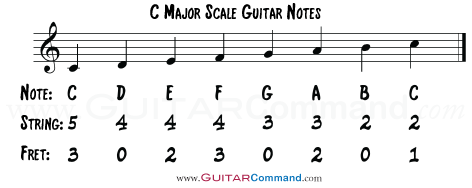
[ad name="Google Adsense Lge Rec"]
The diagram above shows a C major scale. Underneath each note is the string number* and fret number, showing where the note can be played on a guitar. To see where the notes are on a guitar fretboard, use the diagram here: Guitar String Notes. The C major scale can be seen in TAB here: How To Read TABs.
* The lowest guitar string is the 6th string, the highest is the 1st string.
Note Elements
The position of a note on the stave, and the type of note itself, determines how the notes should be played. A note consists of two parts: the notehead and the stem. The notehead is the rounded shape that appears on or between the lines of the score. The stem is the line that extends upwards or downwards from the notehead.
Some notes do not have stems, and consist only of a notehead.
Ledger Lines
Ledger lines are small horizontal lines that are used when the note is either too high or too low to appear on the main five lines of the stave. Ledger lines are simply a continuation of the lines of the stave.

Note Durations
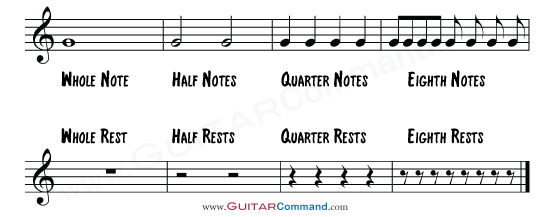
In this lesson, we are going to concentrate on music that consists of quarter notes, eighth notes and half notes. Be aware that there are notes and rests with smaller and larger durations which are not covered here. A rest is a pause in which nothing is played.
A quarter note is one 'beat'. We learned about beats and rhythm in the strumming patterns for guitar lesson. The most common rhythm in music is four beats to the bar. This usually means that there are four quarter notes in a bar. If you find your foot tapping to a piece of popular music, it is likely that you are tapping 'one, two, three, four'; the four quarter notes in a bar.
Some music has three beats to the bar. This is known as 'waltz time'. Try counting 'one, two, three, one, two, three' repeatedly, putting an emphasis on the 'one' beat, to hear this distinctive rhythm.
There are many other ways of counting music, and you will encounter these as you progress.
Dotted Notes
If a note has a dot immediately behind it, then the duration of the note is increased by half again. Therefore a dotted quarter note will last one and a half beats.
Key Signatures
A key signature is the term used for the sharps or flats at the beginning of each staff of music, just after the clef and before the time signature. If there are no sharps or flats, then the key signature is C major (or A minor - each major key has a relative minor).

Key signatures show what key the music is in. The important thing to remember is that the key signature affects all of those notes in the music that follows. Therefore, if a key signature contains an F sharp, then all of the F notes in the music should be sharpened, i.e. played as F sharps. The notes should only be played without being sharpened or flattened if a natural sign is placed before the note.
'Sharpened' means play the note a semitone higher, which on the guitar means one fret higher. Flattened is the opposite: on the guitar, play the note a fret lower.
The key signature can change during a piece of music. If this occurs, the previous key signature is disregarded and the new one takes effect.
Sharps and flats can be placed in front of notes anywhere in the music, not just in the key signature. All subsequent notes of that pitch in that bar should also be sharpened or flattened. The note should then be played normally in the next bar, unless it has been sharpened or flattened again.
Natural Sign

A natural sign placed before a note always means that the note is played without a sharp or a flat.
The key of C major contains no sharps or flats, and all of the notes in the music examples below are therefore played as seen.
Time Signatures
Time signatures show how the music is counted. They consist of two numbers, one over the other. The top number shows the number of beats in the bar, the bottom number is the duration of the beat. In common, or four-four time (4/4), there are four quarter notes in each bar. In three-four time (3/4) there are three quarter notes to a bar. However, in time signatures such as 12/8, there are actually four beats to the bar, divided into three eighth notes.

Putting It All Together - Three Example Melodies In C Major
There is a large amount of information in this lesson, so don't worry if it doesn't all sink in straight away. Take it piece by piece, and refer back to a particular section whenever you need a reminder.
When you are feeling confident, have a go at reading the following popular melodies.
TAB has been included, but you should try to read only the notes at first!
Michael Row The Boat Ashore Guitar Tab
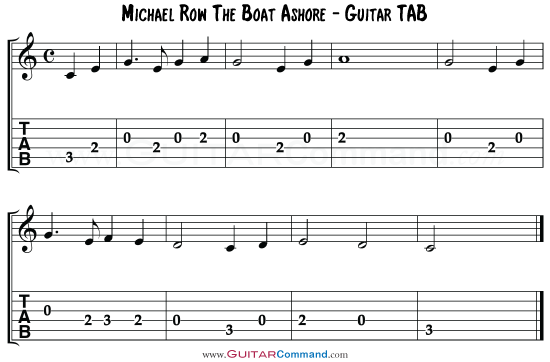
London's Burning Guitar TAB
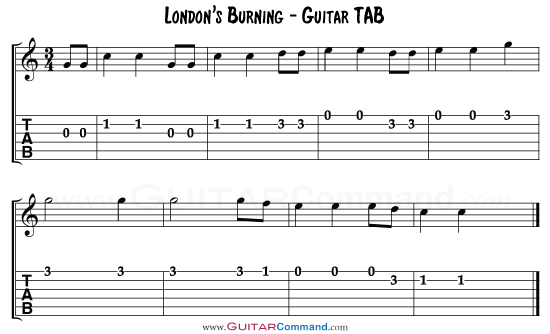
All Things Bright And Beautiful Guitar Tab
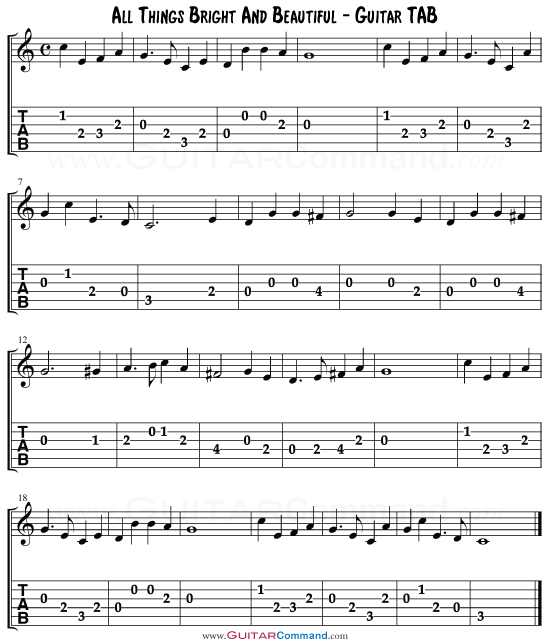
How Long Does It Take To Learn To Read Music?
Learning how to read music for guitar is not something that will happen overnight. You do have to make an effort and play from notation whenever you can. In time you will find it easier to read music than tab. In a few years you will be able to sight-read complex music even if you have never seen or heard it before.
Do I Need To Learn To Read Music for Guitar?
While it is not absolutely necessary for electric or acoustic guitarists to be able to read music, there are situations in which it will be beneficial. For example, when conversing with musicians who are not guitarists and who are used to reading music rather than improvising.
How To Read Music For Guitar - Conclusion
As we have already said, there is a large amount of information in this lesson, and you are not expected to take it in all at once. Once you know the basics of reading music, the best thing you can do to get better is practice, practice, practice. You should try to read any music you that can get hold of - even if it is not guitar music.
We hope that you have enjoyed this lesson. Please let us know what you think in the comments below, and don't forget to bookmark this page for future reference.

